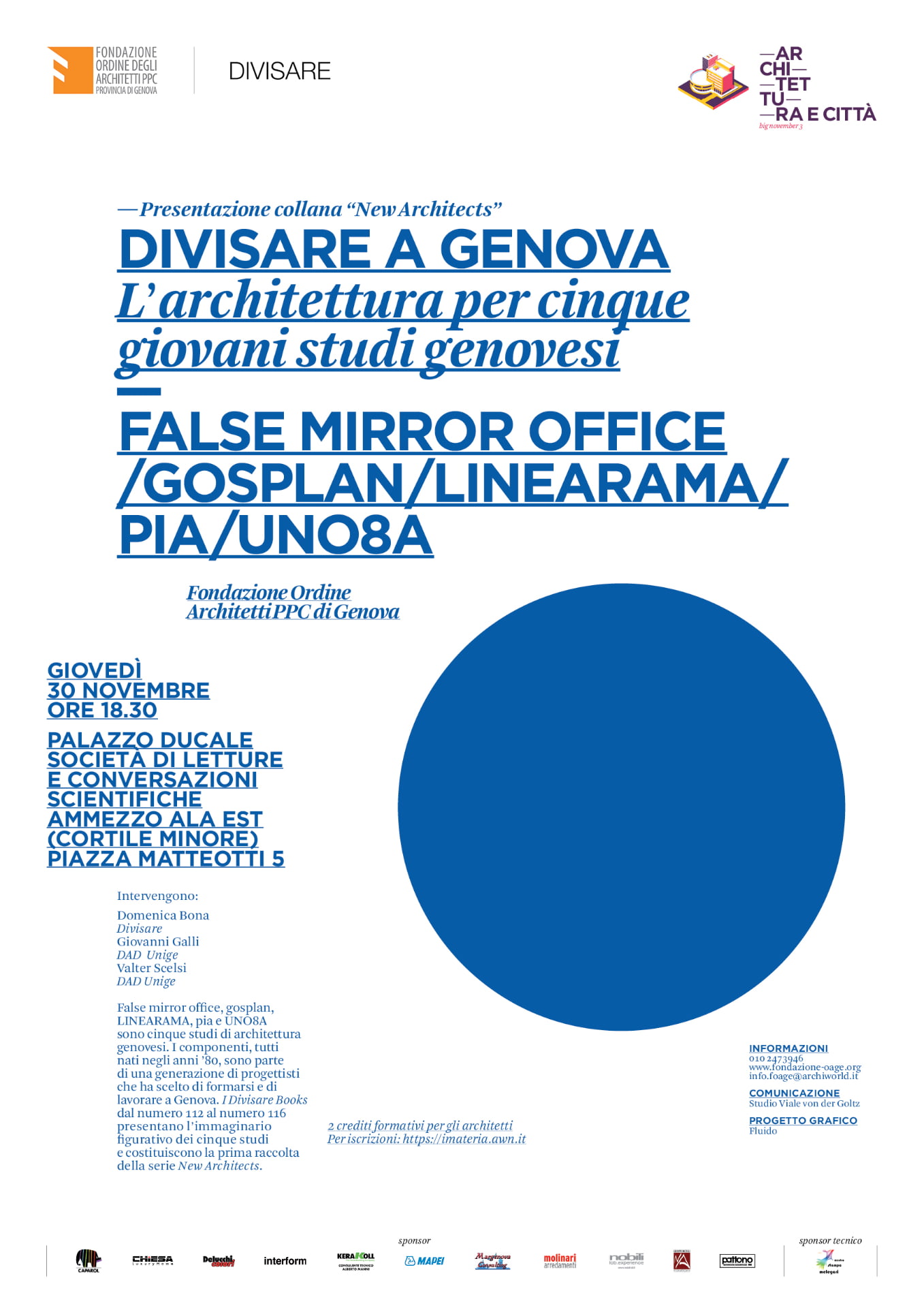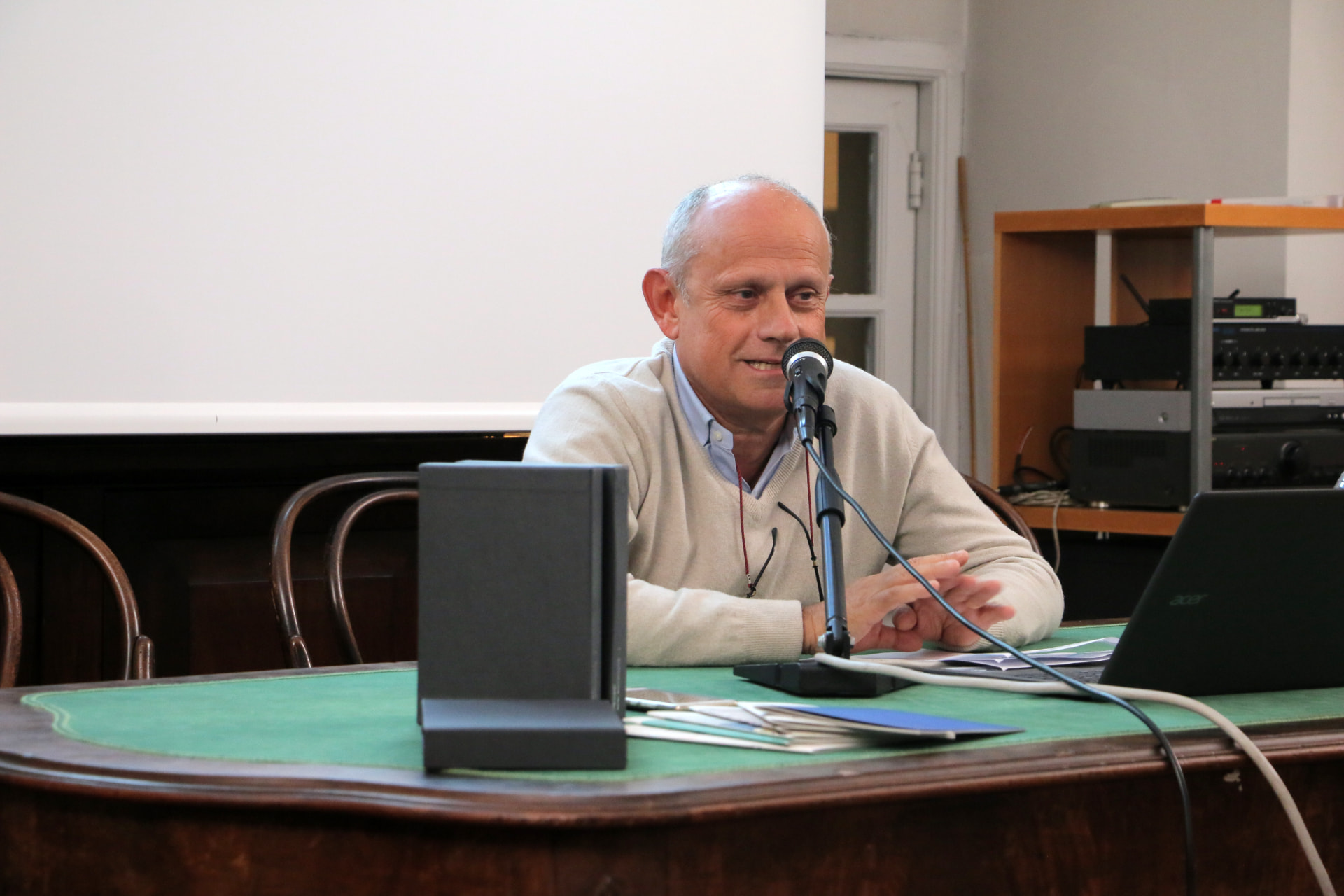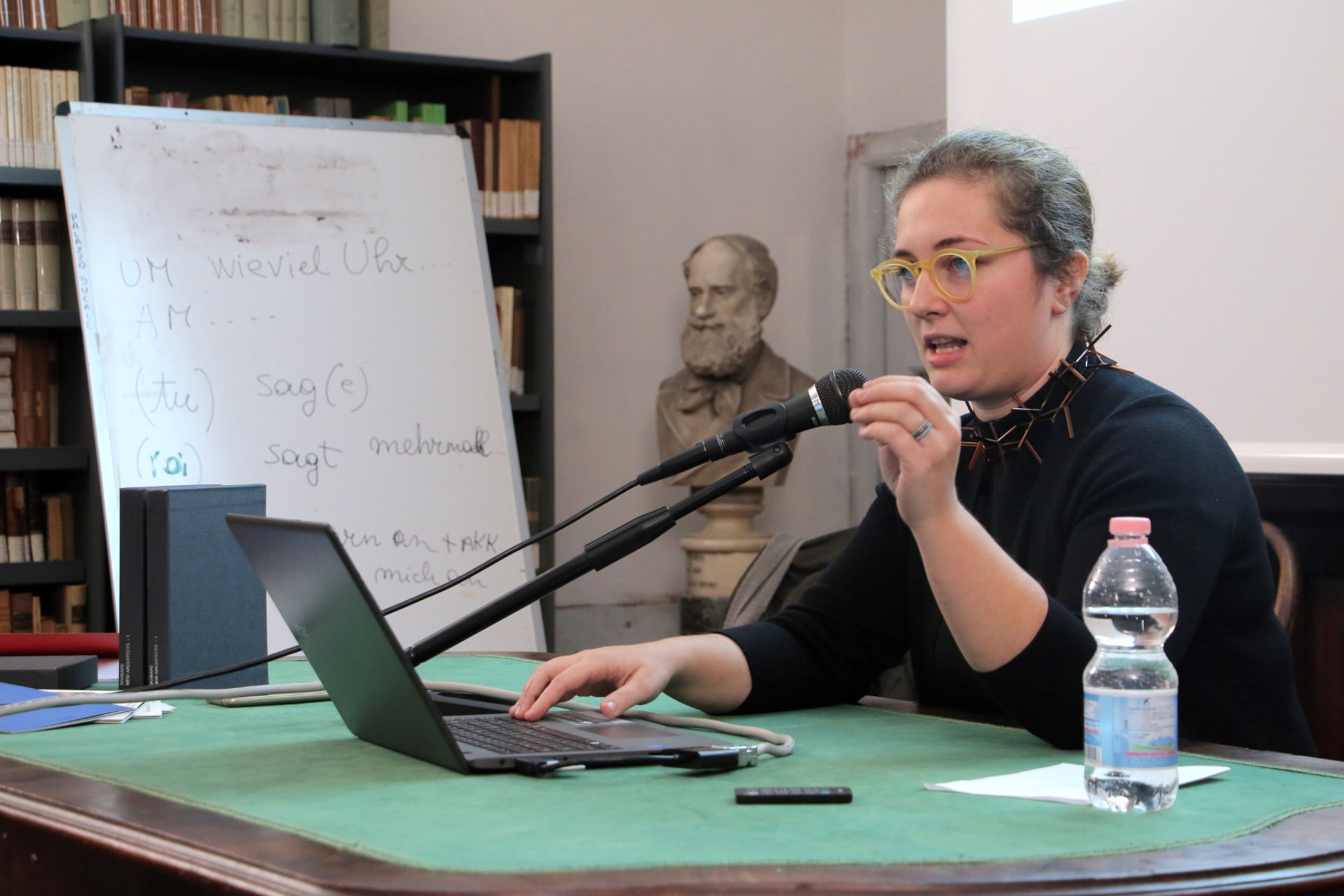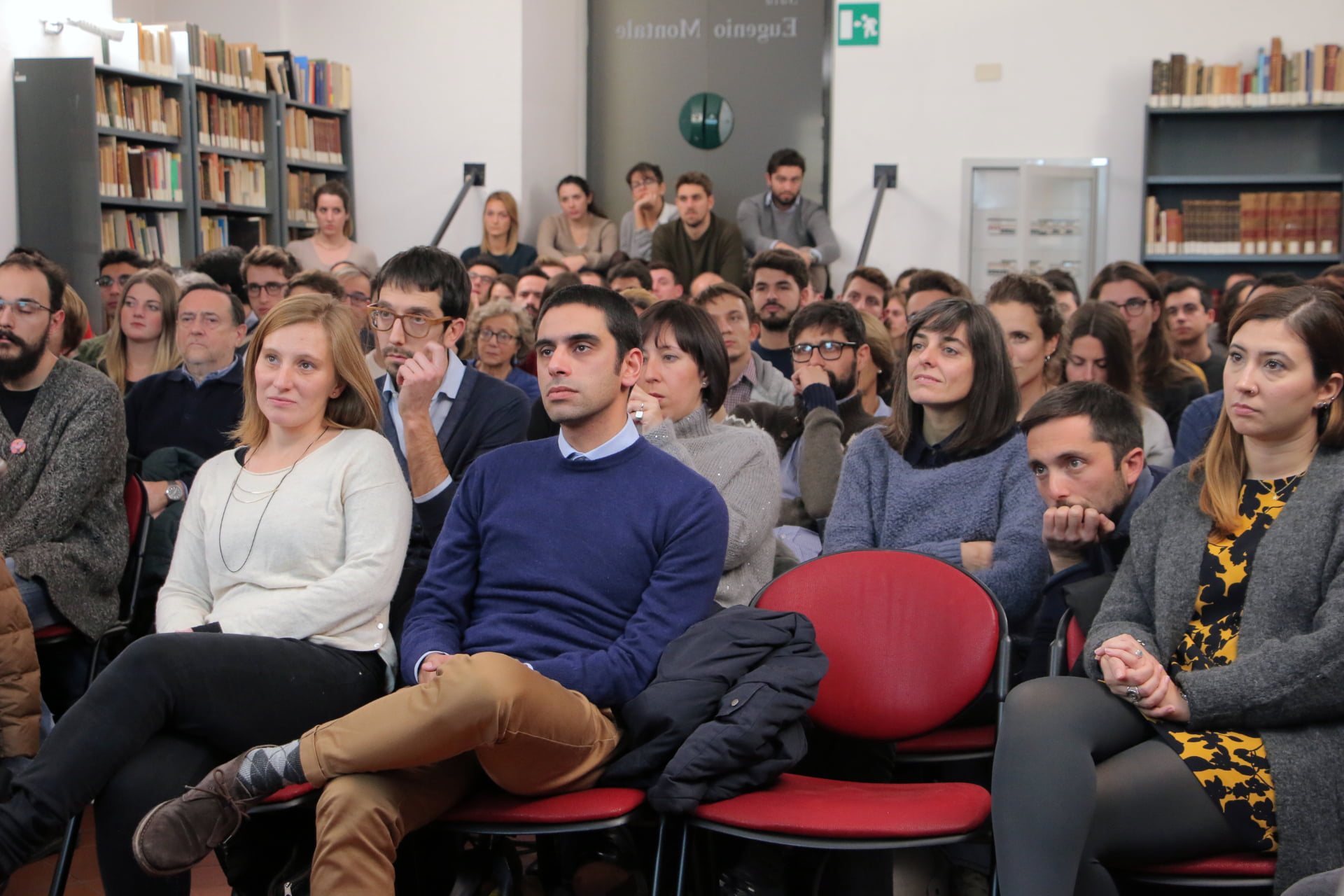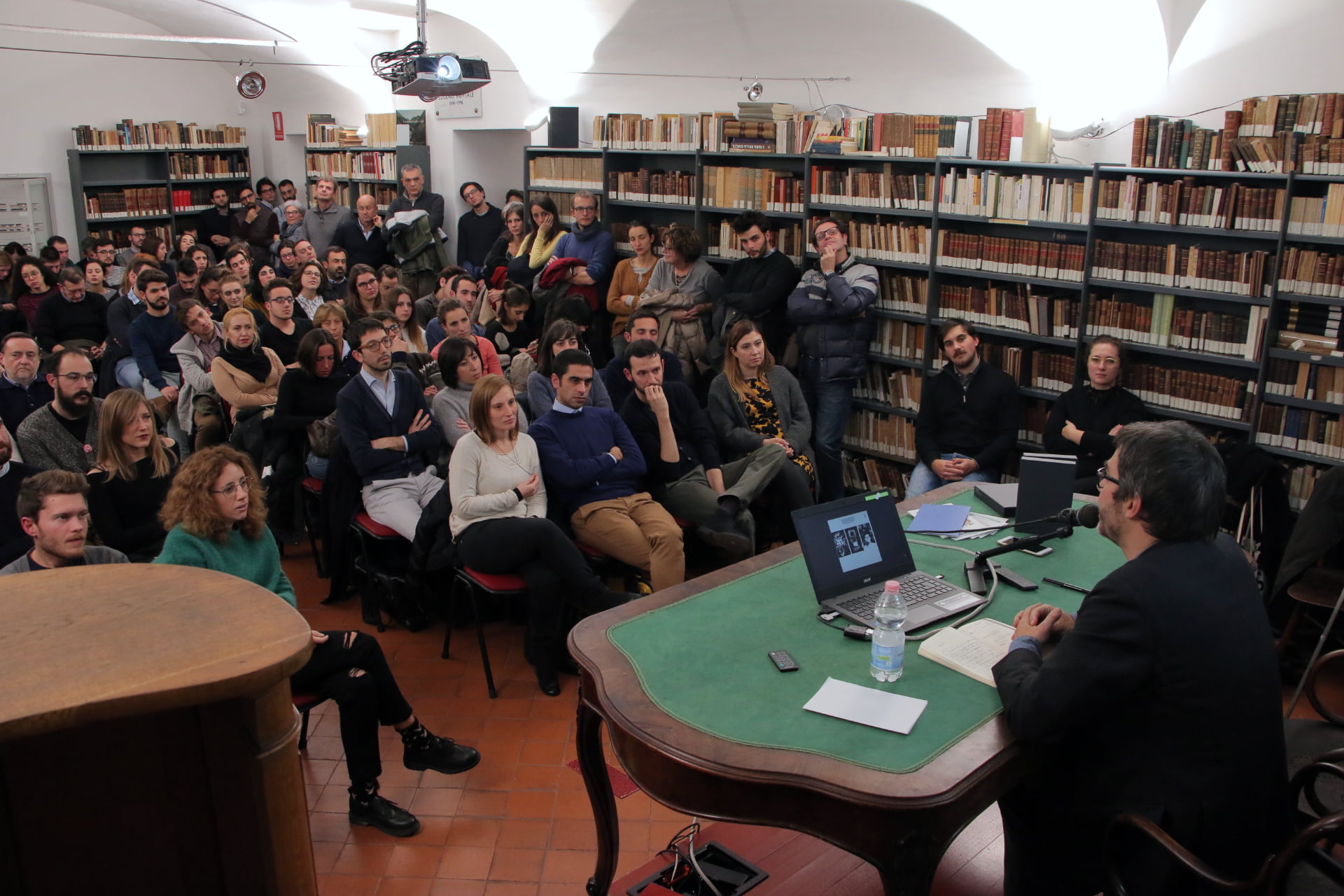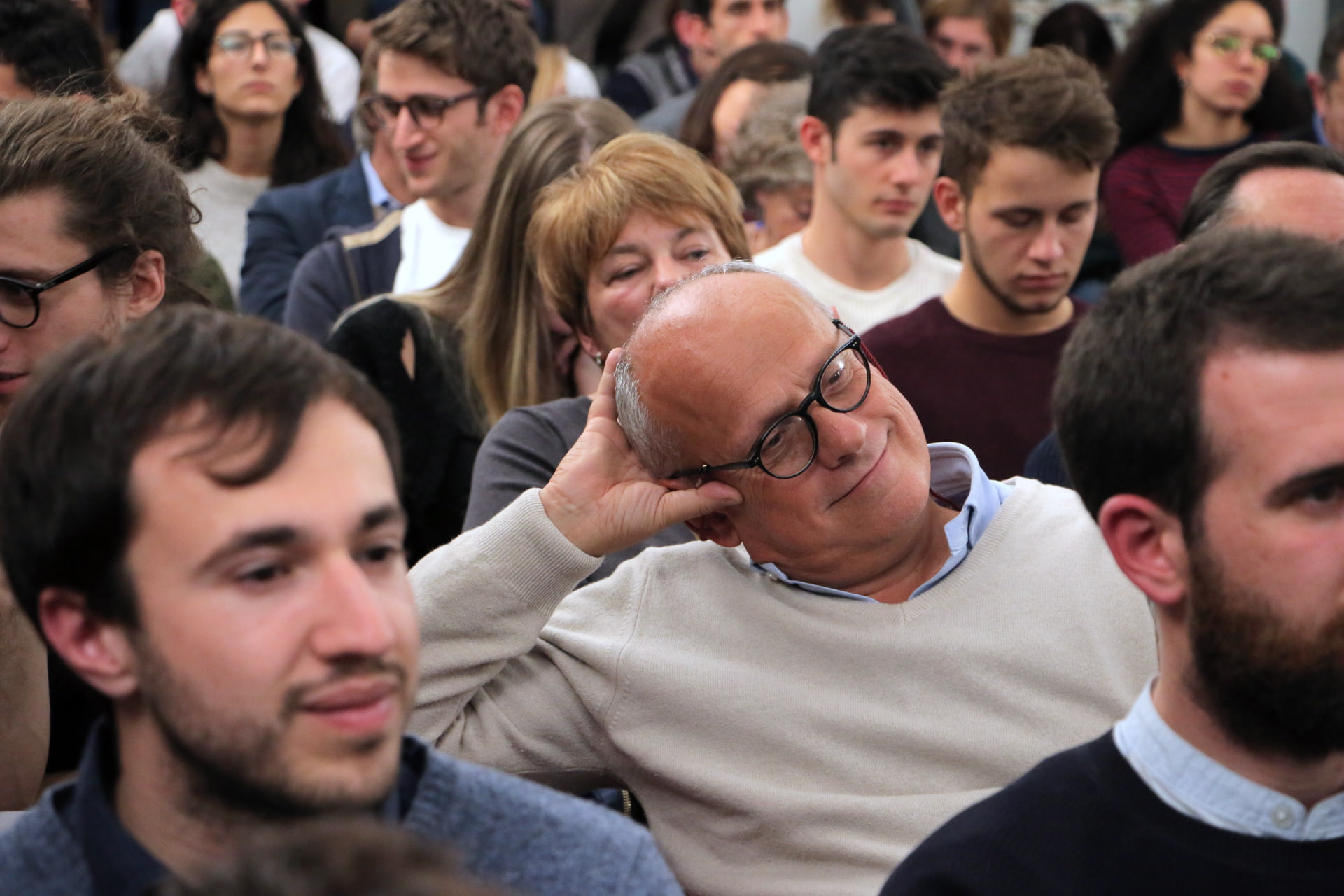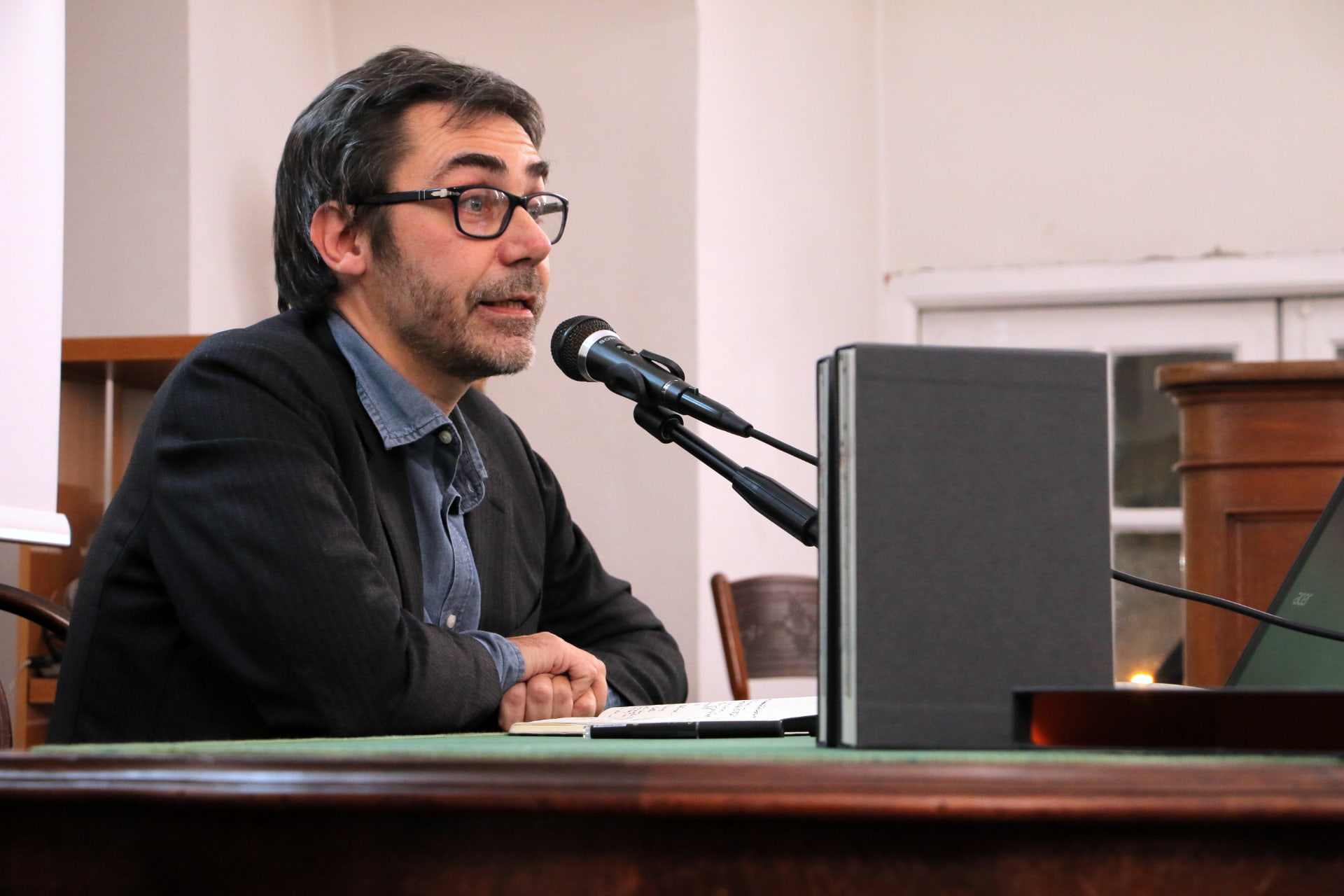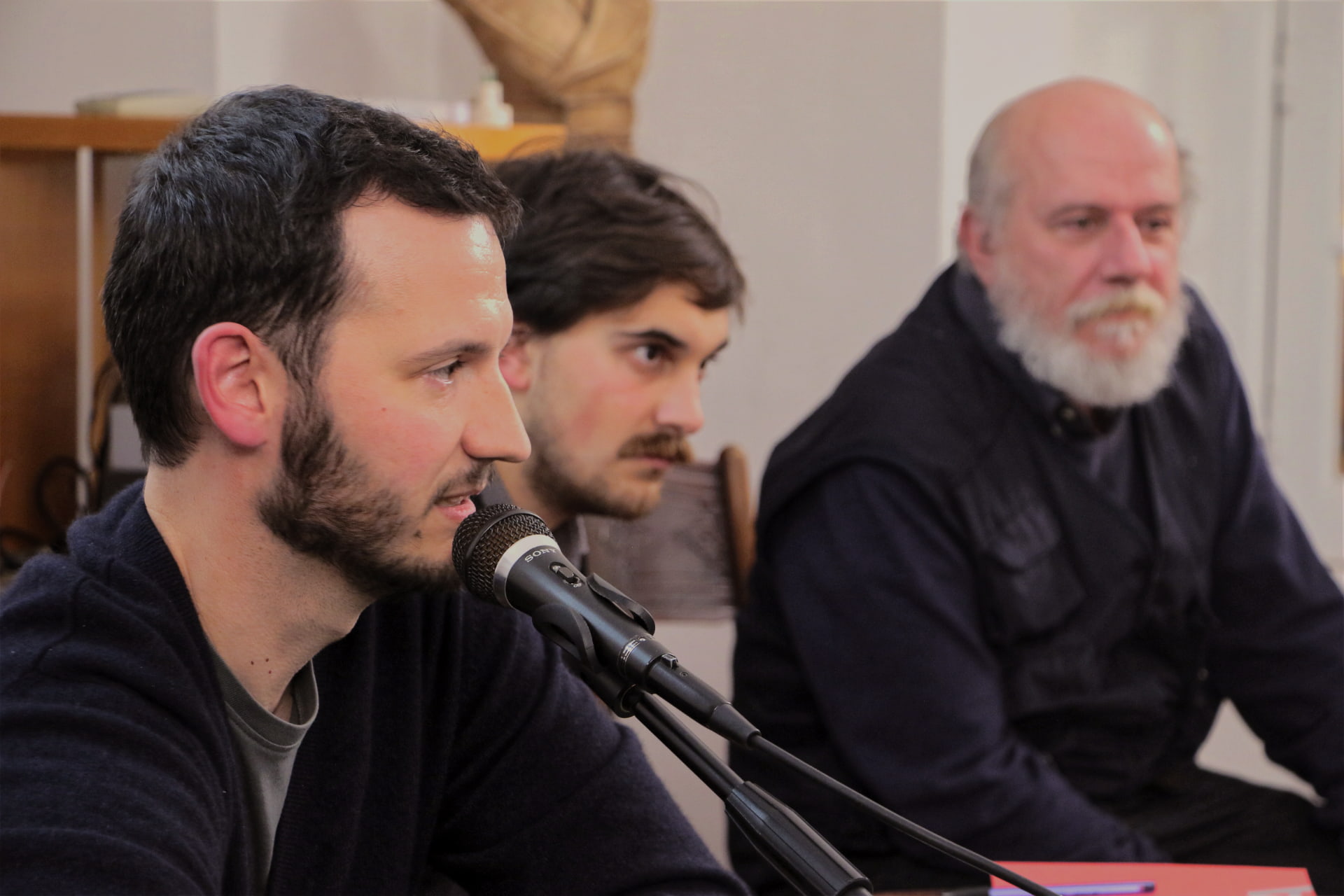
❖ «I don’t think we should go for a manifesto. Our shared working method doesn’t come from a school of any sort: neither we have a specific assumption to respect nor Masters to follow. »
☐ «True. I think that this may also depend on a local factor: the fact is that we all studied in Genoa, where Architecture School is actually pretty lay, composed by a motley staff lacking of a main leading figure. »
❖ «That’s true, in fact… what do you think about these few lines? “We come from a non-school. Our first common root is the defection of paradigm and super-ordinate interpretations, being it an absolute belief or corporate codes: so far we do have a responsible approach open to critics and changes.”
☐ «It makes sense, but to me it sounds like the typical snobbish curriculum vitae… so conformist…»
✳ «We have to admit that Genoa’s factor strongly influenced us: The Faculty of Architecture is small but its intromission in the city fabric led to an extraordinary urban success. The school has been for all us a happy place where to hang out during university years and, above all, where to confront and discuss. That place surely trained our approach to the discipline, this continuous need of comparison that is still very vibrant today. »
❖ «It’s clear that to join forces and collaboration for us is definitely more complicated. We are all complementary professionals, we don’t differ much in competences. Yet this is a convenient way to free our mind from assumptions and aprioristic certainties. »
◎ «This I think is something important to be explained. Nowadays the act of creating a network of different professionals is a commonplace, to collaborate in a co-working is too often taken for granted as it was a kind of mandatory method to accomplish a complex process such as the architectural design.
We tend to the exact opposite: we all are overlapping figures, each one of us is an Architect. Teamwork for us does not simplifies things but builds up a conflict of opinion and matters between each other’s piece of mind. Moreover, we believe – and we happened to prove this in multiple occasions – that this conflict allows us to reach further goals, and that from such dialogues we achieve an otherwise unreachable synthesis. May this will to create a community of relations be our very common ground? Anyway, this is the inner sense of architecture itself, as any other medium is…»
● «Not another rant about media, please… »
✳ «I think this sounds more like “The whole is other than the sum of the parts”»
◎ «In a sense, our opinion is antithetical to the ideology of professionalism, because architecture has to be first of all an intellectual activity. Don’t get me wrong: not only theoretical speculation, but neither ordinary task-filling. The fact of always changing and adapting for any new commission, competition, graphic or design strategy, team composition… is a non-professional approach: a true professional optimizes until the right framework is found, and then repeats it. »
☐ «You know, giving an intellectual meaning to our work beyond use and quantity is the reason why we drain so much energy working together. Although I don’t deny: it’s such an effort: nothing ever predefined, nor equal or repeated… »
✳ «If we have so much time to spend on discussion is because of economic crisis, isn’t it?»
● «Seriously? Do we want to turn it on crisis talk? I agree with it, this is in fact a portrait of current times, but think about this: we start with localism, now crisis and lack of work… we’ll end up with the manifesto of depression! »
◎ «Radicals and La Tendenza raised from 70s crises, in some way… »
● «Do you see the problem in keeping us too long in a locked room? Anyway… If you ask me to go for a specific topic, I would go for our love for drawings. In general. The meaning that we give to the representation of Architecture. »
❖ «We all agree on this.»
☐ «Drawing never lies. »
✳ «Are you serious? The entire history of Architecture is full of drawings that tampers reality, that doesn’t match with it…»
◎ «That is not lying. That is meaning something more. Any drawing is representing something more than mere reality, but tells an idea which differs from reality. In this sense drawing never lies on what is core: it can fake a dimension, but it honestly depicts the culture of its maker without uncensored, showing his capacity to handle details, to enhance graphical features, to never settle for an established aesthetic.
● « “Drawing is time.” And I mean… the time spent on drawing is the same that you need to understand the project. »
◎ «We are talking about operative drawing, not a simple restitution, right? It has to be a tool to read the whole world; for that, it must not be an end in itself. »
☐ «That is what I fear the most: if we focus on our care for representation and its role in our group, we end up describing ourselves as pencil-addicts…»
◎ «Obviously not. Hyper-professionalism and pencil-addiction are two sides of the same coin, two contrapositive stereotypes on architects in general. The first refers to the world of international firms, bond in multi-disciplinary professional networks where different skills and specializations create astonishing designs of futuristic dream cities.
The second describes architects as useless highbrows in love with aesthetic matters which end up with bugged design solutions at their best. Or else: we don’t even make buildings, but drawing, talks, theories… for the sole sake of it.
We could in fact state that our relation with representation does not need to sound narcissist nor managerial…»
● «But, come on guys: let’s say that we are having fun! It all sounds so sad…! »
☐ «Right. In the end, what do we usually do? We gather ideas, we have fun, we all lose competitions…»
◎ «Ok, I think we are almost there. On one hand, we have the location-based condition and the contingencies, on the other the centrality of representations, architecture as an intellectual matter – an oxymoron that contains the dual polemical nature of the design process. Now we just need someone to write it down and connect them all.
Do someone offers himself as volunteer to do this? »
● «I was wondering… Why don’t we go with a transcript? It is actually the most honest way to describe our method: constructing a dialogue. »
☐ «That’s it. In a sense that also this is a form of representation. »
◎ «It also proves that the medium is the message. In other words, the way you represent your idea is equally important as the idea itself. »
☐ «No please: not McLuhan, not again…»
✳ «It is our non-manifesto… It’s a dialogue, a stream of consciousness…»
❖ «Don’t you think someone may have already done it?»
☐ «Everything has already been done. »
❖ «Non penso che dovremmo redigere un manifesto. Il nostro gruppo, anzi il nostro modo di lavorare insieme non è caratterizzato da una scuola: non abbiamo né paradigmi fissi da rispettare, né tantomeno maestri da imitare»
☐ «È vero. Credo che questo dipenda anche da un fattore locale: il fatto di aver tutti studiato a Genova. Qui la scuola di architettura in un certo senso è laica, con un corpo docenti eterogeneo che non si è mai riconosciuto in una figura carismatica»
❖ «Ma sì, infatti… vi leggo queste quattro righe che mi ero segnato su questo argomento: “Proveniamo da una scuola che forse tanto scuola non è. La principale radice delle idee che ci sentiamo di portare avanti attraverso il progetto dell’architettura è l’assenza di paradigmi e di interpretazioni preordinate, cioè di un credo assoluto o di codici rappresentativi ‘corporativi’, che lascia spazio alla costruzione di un atteggiamento consapevole e disponibile a contaminazioni e domande”»
☐ «Il concetto è giusto. Lo stile è un po’ troppo perbenista, fa un po’ curriculum vitae…»
✳ «Beh, però il fattore Genova ha contato molto per noi, anche per il fatto che la facoltà è piccola ed è il risultato di un’operazione urbanistica e architettonica ben riuscita. La ‘facoltà’ è stata per tutti noi un piacevole luogo del quotidiano, un luogo di studio ma soprattutto un vero punto di incontro, confronto e condivisione. Questo luogo e questo clima in un certo senso hanno formato il nostro approccio alla professione, la necessità di un continuo confronto ci caratterizza tutt’oggi»
❖ «È chiaro che unire le forze e lavorare insieme è più complicato. In effetti nel nostro caso siamo figure complementari e non specializzate in settori differenti. Però questo può essere anche una risorsa utile a liberarci da preconcetti e certezze aprioristiche»
◎ «Mi sembra importante sottolineare questo punto. Oggi si cerca sempre di esaltare le potenzialità del network, del co-working perché la progettazione degli edifici trae grande vantaggio dalla costruzione di gruppi che tengono insieme professionalità diverse e complementari. Ecco, noi siamo l’opposto di questo modello: noi siamo tutte figure sovrapponibili, siamo tutti architetti. Lo sappiamo bene che lavorare insieme non semplifica affatto le cose, anzi le complica perché genera un conflitto tra quello che penso io e quello che pensa chiunque altro di voi! Però noi siamo convinti, e in qualche modo abbiamo anche verificato che da questo conflitto e dal dialogo che ne scaturisce, si possa arrivare ad una sintesi che è sicuramente migliore di tutte le iniziali idee dei singoli. È un po’ la voglia di costruire una comunità di relazioni, una specie di ‘common ground’… che poi è il senso dell’architettura, come di tutti gli altri media»
● «Basta che non diventi il solito sproloquio sui media…»
✳ «Secondo me è un po’ il discorso che ‘il tutto è più della somma delle parti’»
◎ «In qualche modo il nostro punto di vista è antitetico alla ‘ideologia del professionismo’, perché l’architettura è prima di tutto un lavoro intellettuale. Non pura speculazione, ma neppure puro professionismo. Anche il fatto di cambiare sempre, per ogni nuovo progetto, grafica, strategia progettuale, composizione del team, è un atteggiamento anti-professionistico: il professionista ottimizza e una volta che ha trovato la formula giusta, la ripete»
❖ «Io direi che la ragione che ci tiene insieme e che ci fa ‘sprecare’ tante energie è cercare di attribuire al lavoro un valore intellettuale al di là dell’uso e della quantità. Questo modo di fare è uno sforzo continuo, ogni volta nuovo e mai predefinito»
☐ «Beh, se abbiamo tanto tempo da dedicare alla discussione, non sarà anche un po’ merito della crisi?»
● «Ma scusa, vogliamo davvero giustificarci con la crisi? Io concordo su tutto, del resto stiamo fotografando il contesto e il tempo, però attenzione: prima la realtà di provincia, ora la crisi e la mancanza di lavoro, così rischiamo di scrivere un manifesto della depressione!»
◎ «Però anche l’architettura Radicale e la Tendenza devono qualcosa alla crisi degli anni ‘70»
● «Ecco: questo è il rischio di lasciare soli tanti architetti in una stanza a discutere. Volendoci però focalizzare su un punto è verissimo che tutti noi abbiamo molto a cuore la questione della rappresentazione dell’architettura»
❖«Su questo siamo tutti d’accordo»
☐ «Il disegno non mente mai»
✳ «In che senso? Ma se la storia dell’architettura è piena di disegni che manomettono la realtà, che non le corrispondono…»
◎ «Quello non è mentire. È voler dire qualcosa di più. Il disegno non descrive semplicemente la realtà. Racconta un’idea diversa di realtà. In questo senso il disegno non mente mai su ciò che è essenziale. Può contraffare una misura, ma racconterà senza censure la cultura di chi lo ha prodotto, documentando la sua capacità di curare i dettagli, di ricercare la massima efficienza grafica, di non accontentarsi di prendere a prestito un’estetica già affermata»
● «Il disegno è tempo. E intendo che il tempo impiegato a disegnare il progetto è anche quello che ti serve per capire il progetto»
◎ «Che poi il disegno di cui parliamo non è un disegno ‘restitutivo’, ma piuttosto un disegno ‘operativo’. Uno strumento attraverso cui si legge e racconta il mondo. Per questo non deve mai essere ozioso o fine a sé stesso»
☐ «Ecco io vedo un po’ questo pericolo. Che sottolineare l’amore per il disegno e il primato del disegno stesso, finisca col farci vedere come dei ‘matitari’»
◎ «No, certo, super-professionista e ‘matitaro’ sono due facce della stessa medaglia. Sono un po’ i due principali e antitetici racconti secondo cui è percepita oggi la figura dell’architetto. Il primo si riferisce alla retorica del grande professionismo, quello degli studi internazionali e dei network multidisciplinari, dove professionisti con diverse specializzazioni producono edifici mirabolanti e tecnologicamente avanzati.
Il secondo invece descrive gli architetti come una comunità di inutili intellettualoidi, innamorati di questioni estetiche irrilevanti che nel migliore dei casi producono edifici complicati e pieni di problemi. Anzi forse non producono edifici affatto, ma solamente disegni, discorsi, teorie.
In effetti potremmo chiarire meglio che la nostra posizione (penso in fondo quella di tutti) nei confronti del disegno non vuole essere né narcisistica, né manageriale»
✳ «Dovremmo anche dire che ci divertiamo…!»
● «Ma sì, dai, alla fine quello che facciamo è mettere insieme idee, ci divertiamo un casino e perdiamo sempre!»
◎ «Allora, diciamo che i concetti ci sono. Da una parte le coordinate geografiche e temporali. Dall’altra la centralità del disegno e la concezione dell’architettura come lavoro intellettuale, un ossimoro che racchiude tutta la natura dialogica, perfino polemica, nel senso di conflittuale, del progetto. Però le varie parti che abbiamo discusso sono un po’ sconnesse. C’è qualcuno che si offre di provare a sintetizzarli in un contributo unico?»
● «Scusate, ma se invece trascrivessimo questa discussione di oggi? In fondo è il modo più onesto per raccontare un metodo, che poi fondamentalmente è la costruzione di un dialogo»
☐ «Mica male! In un certo senso anche questa è una forma di rappresentazione»
◎ «Ribadisce con forza il concetto per cui il modo con cui rappresenti una cosa è più importante del contenuto stesso che vuoi affidare a questa rappresentazione. ‘The medium is the message’ direbbe il vecchio Marshall»
☐ «No, ti prego, di nuovo McLuhan…»
✳ «Un timido non-manifesto, è un dialogo…una sorta di stream of consciousness…»
❖ «Non è che qualcuno lo ha già fatto?»
☐ «Tutto è già stato fatto»




